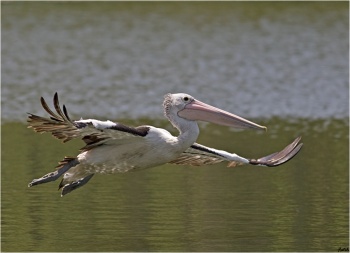(→External Links: New combined GSearch. GSearch checked template) |
|||
| (11 intermediate revisions by 6 users not shown) | |||
| Line 1: | Line 1: | ||
| + | [[Image:Australian_Pelican.jpg|thumb|550px|right|Bird shown is in breeding plumage<br />Photo © by {{user|Neil|Neil Fifer}} <br />Near Sydney, [[Australia]]]] | ||
;[[:Category:Pelecanus|Pelecanus]] conspicillatus | ;[[:Category:Pelecanus|Pelecanus]] conspicillatus | ||
| − | |||
| − | |||
| − | |||
==Identification== | ==Identification== | ||
| − | + | Length 160-180 cm, (70-71 in.) wingspan 230-260 cm, (90-91 in.) and weight 4-6.8 kg.<br /> | |
| − | + | Mainly white, with black tail, primaries, secondaries and inner secondary coverts; also a narrow black wingbar on underside of wing. Very large pale, pinkish bill; dark eye with pale yellow or white eye ring. | |
==Distribution== | ==Distribution== | ||
| − | [[Australia]] | + | [[Australia]] and [[Tasmania]]; winters to [[New Guinea]] region |
| − | |||
==Taxonomy== | ==Taxonomy== | ||
| − | + | This is a [[Dictionary_M-S#M|monotypic]] species<sup>[[#References|[1]]]</sup>. | |
| − | |||
| − | |||
| + | An extinct subspecies ''P. c. novaezealandiae'' has been described from subfossils in New Zealand<sup>[[#References|[2]]]</sup>. | ||
==Habitat== | ==Habitat== | ||
| − | + | [[Image:MG 0087 BF.jpg|thumb|350px|right|Photo © by {{user|fthsm|fthsm}}<br />Olympic Park, Sydney, [[Australia]], December 2008]] | |
| − | + | Marine and freshwater environments, lakes and rivers. | |
==Behaviour== | ==Behaviour== | ||
| − | They nest communally. The nest is a shallow depression in earth or sand, sometimes with some grass lining. | + | ====Breeding==== |
| − | + | They nest communally. The nest is a shallow depression in earth or sand, sometimes with some grass lining. Up to three chalky white eggs are laid. | |
| + | ====Diet==== | ||
The diet includes fish. | The diet includes fish. | ||
| + | ==References== | ||
| + | #{{Ref-Clements6thAug14}}#Scarlett, R. J. (1966). A Pelican in New Zealand. ''Notornis'' [http://web.archive.org/web/20081018071145/http://www.notornis.org.nz/free_issues/Notornis_13-1966/Notornis_13_4.pdf 13: 204-217]. | ||
| + | #Wikipedia | ||
| + | #BF Member observations | ||
| + | {{ref}} | ||
| + | ==External Links== | ||
| + | *[http://www.arthurgrosset.com/ozbirds/australianpelican.html Arthur Grosset's Birds] | ||
| + | <br /> | ||
| + | {{GSearch|"Pelecanus conspicillatus" {{!}} "Australian Pelican" {{!}} "Australian White Pelican"}} | ||
| + | {{GS-checked}}1 | ||
| + | <br /> | ||
| + | <br /> | ||
| − | |||
| − | |||
[[Category:Birds]][[Category:Pelecanus]] | [[Category:Birds]][[Category:Pelecanus]] | ||
Latest revision as of 01:00, 8 April 2023
- Pelecanus conspicillatus
Identification
Length 160-180 cm, (70-71 in.) wingspan 230-260 cm, (90-91 in.) and weight 4-6.8 kg.
Mainly white, with black tail, primaries, secondaries and inner secondary coverts; also a narrow black wingbar on underside of wing. Very large pale, pinkish bill; dark eye with pale yellow or white eye ring.
Distribution
Australia and Tasmania; winters to New Guinea region
Taxonomy
This is a monotypic species[1].
An extinct subspecies P. c. novaezealandiae has been described from subfossils in New Zealand[2].
Habitat
Marine and freshwater environments, lakes and rivers.
Behaviour
Breeding
They nest communally. The nest is a shallow depression in earth or sand, sometimes with some grass lining. Up to three chalky white eggs are laid.
Diet
The diet includes fish.
References
- Clements, J. F., T. S. Schulenberg, M. J. Iliff, D. Roberson, T. A. Fredericks, B. L. Sullivan, and C. L. Wood. 2014. The eBird/Clements checklist of birds of the world: Version 6.9., with updates to August 2014. Downloaded from http://www.birds.cornell.edu/clementschecklist/download/
- Scarlett, R. J. (1966). A Pelican in New Zealand. Notornis 13: 204-217.
- Wikipedia
- BF Member observations
Recommended Citation
- BirdForum Opus contributors. (2024) Australian Pelican. In: BirdForum, the forum for wild birds and birding. Retrieved 10 November 2024 from https://www.birdforum.net/opus/Australian_Pelican
External Links
GSearch checked for 2020 platform.1





